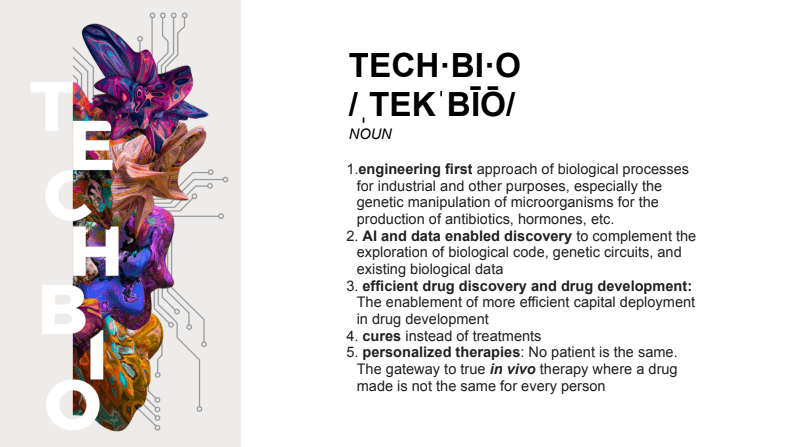We are now living in what I’m calling the TechBio revolution. That’s not a typo that should read BioTech, but rather a new way of looking at the convergence of technology and biology.

TechBio is defined as an engineering-first approach of biological processes for industrial, and other purposes, especially the genetic manipulation of microorganisms for the production of antibiotics, hormones, and so on. A process that uses AI and data-enabled discovery to complement the exploration of biological code, genetic circuits, and existing biological data. A focus on efficient drug discovery and development cures instead of treatments, and personalized therapies that recognize no two patients are the same.
This new era of TechBio and the redefinition of biotechnology has only been made possible by relatively recent breakthroughs in both science and tech, which we have narrowed down to seven trends. If even one of these things were not happening we would not be at this tech-bio convergence with the promise it holds to transform existing models of healthcare.
1. Sequencing Costs Have Collapsed
In 2001 it took months and $100 million to sequence just one human genome, but by 2015 the cost had dropped to less than $1,000 and could be done in just a few hours (National Human Genome Research Institute). It’s projected that this year NovaSeq will bring that cost to only $100, meaning in just the last 20 years sequencing costs have decreased by six orders of magnitude (GenEng News). The decreasing costs have enabled wide-stream usage of gene sequencing and provided an influx of information to researchers and companies that were once only reserved for the most well-funded research labs. The widestream usage has, in essence, providing an ability to “open source” science and R&D in a way that looks similar to tech code sharing, all thanks to the internet revolution.
2. The Digitization of Biology
It used to be that if a rare disease or biomarker was discovered, it would be recorded in a lab notebook and that was it unless it was published in a scientific journal. Health data from consumers en masse wasn’t even a thing. In addition, information wasn’t really shared because there was no way to do it. Now there is not only a major movement to digitize information, but also to commercialize and consumerize it. Well-known examples of this are Ancestry.com and 23andMe. These companies are enabled, in part, by low sequencing costs, but also the fact that software has enabled us to communicate this language of biology, and now we also have an ability to store this in a very efficient way, which allows us to collaborate with our genetic code.
3. Better Data and Advanced Computing
Consider that over 90 percent of the world’s data has been created in just the last three years and that every day we create 2.5 quintillion bytes of data (Forbes). But it’s not just the quantity of data created that is making a difference, it’s the quality. It’s no secret that you need good quality data to make inferences, which leads to advancements in AI.
AI is a buzzword today, but it’s not a new concept. Fundamentally, AI has been around for decades, but in a simpler form. At its base level, all AI used to be was taking a piece of data, letting it repeat itself, and then allowing it to learn to automate tasks so that humans weren’t required to push a button. Now with the advent of machine learning, and deep learning, we are creating better, more meaningful data.
If you aren’t familiar with the concept of deep learning, watch AlphaGo on Netflix, which is a documentary about a very complex game that it was believed only humans could understand how to make moves for. Yet as the machine learned from the existing moves humans made, it was actually able to make moves that humans did not even know were feasible. In short, humans learned from the machines.
If we apply this idea of deep learning to the world of biology, there could be pathways, mechanisms of action, and various other hidden gems that can completely control the way we live our lives. Things we may not even know, and no amount of scientific experiments run in labs will enable to happen.
4. Limitless Cloud Storage
The software has not only enabled us to communicate the language of biology, but it has also provided cost-effective data storage. It’s projected that by 2021 there will be 1.3 zettabytes of data stored globally, which thankfully it’s projected will cost cents on the dollar to store (Cisco).
Genomics data is expected to require up to 40,000 petabytes of storage each year by 2025, figures that dwarf the expected storage of Twitter (up to 17 petabytes a year), YouTube (up to 2,000 petabytes a year), or all the data collected on astronomy (1,000 petabytes a year) (Plos Biology). The good news is, we are finally at a place where we can store and share this data in the cloud.
5. Skyrocketing Drug Costs
While the cost of storage has dropped dramatically, the cost of drug development is not falling as rapidly. The average cost to develop a new drug in 2019 is $2.6 billion, up from one billion in 2003 (Policy & Medicine). This is an important area, but we have an ethical responsibility to do it the right way – you absolutely cannot hack biology. Yet this trend of skyrocketing drug costs presents an opportunity for us to say “why can’t we do this in a cheaper, more efficient way?”
6. M&A Activity Increasing
Pharma and healthcare M&A activity has not slowed. This is evidenced by the fact that healthcare investments in 2018 surpassed 2017 by more than 50 percent (Modern Healthcare). Big Pharma CEOs have somewhat accepted that the more efficient way to grow is to tap into the innovation from more agile private companies, and research from outside their own corporate walls. This presents a gift to savvy early and mid-stage investors who can seed the innovation that will likely get strategically absorbed into a giant pharma portfolio. What I predict as well, is that more M&A in this space will come from non-traditional healthcare players. Companies like Google, Apple, 3M, and P&G, as the convergence becomes real and these companies find that they are just as well equipped to manage health in ways that it previously only seemed like a giant pharma company could.
7. Biology Talks
All the drugs that have come to market, whether it be an over the counter pain killer or a psoriasis drug, or even cancer therapy, nothing is personalized. Why does one expect that a trial that is largely approved by enrolling one small sample / demographic in one part of the world will work just as well in a person who looks and is different? It doesn’t work.
That’s why I believe the future is in-vivo biology, where drugs will look at my body chemicals and signals and work differently in me than how it will work in you. What will fuel this though is our understanding of biology. We have learned more, and done more, to move biological processes in the past 10 years than in perhaps the past 100 years. From gene editing to novel pathways to discovering new bacteria and viruses, we now have novel biology that can be the fuel for a whole new applied world.
The Era of TechBio
People demand (and deserve) better drugs at better prices, but this will never be a reality unless the TechBio revolution paves the path to the next generation of cheaper, more efficacious, and safer designer drugs.
TechBio is a promising era of modern medicine, embracing the advancements that have already occurred, which are paving the way for the next 20 years of the technology and biology convergence.
About Vasudev Bailey

Vasudev Bailey invests in tech, consumer and healthcare companies as a Partner at ARTIS Ventures. Prior to joining ARTIS Ventures, he helped found enterprise sales and the healthcare business for Quid. He has a Ph.D. in Biomedical Engineering from the Johns Hopkins School of Medicine.

